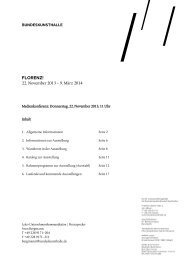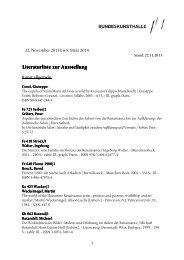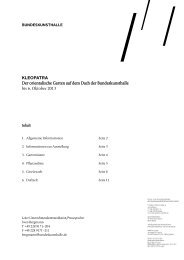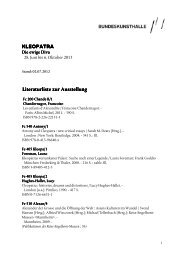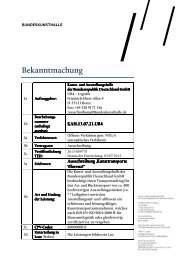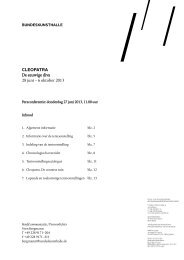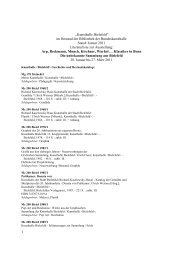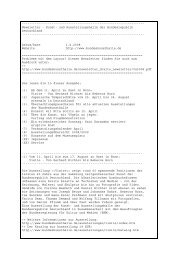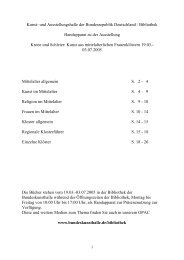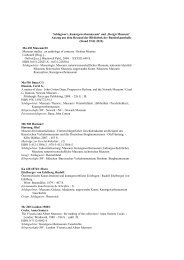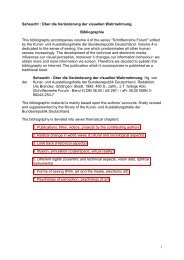Peoples through space and time Archaeology in Germany 09.05 ...
Peoples through space and time Archaeology in Germany 09.05 ...
Peoples through space and time Archaeology in Germany 09.05 ...
You also want an ePaper? Increase the reach of your titles
YUMPU automatically turns print PDFs into web optimized ePapers that Google loves.
25<br />
Urban <strong>Archaeology</strong> - The Rise of a Research Discipl<strong>in</strong>e<br />
Extensive destruction dur<strong>in</strong>g World War II <strong>and</strong> the ensu<strong>in</strong>g reconstruction dur<strong>in</strong>g the 1950s <strong>and</strong> 60s<br />
wiped out <strong>in</strong>valuable archaeological sources <strong>in</strong> <strong>Germany</strong>'s historic city centers. It was not until the<br />
beg<strong>in</strong>n<strong>in</strong>g of the 1970s that urban archaeology developed <strong>in</strong>to an <strong>in</strong>dependent research discipl<strong>in</strong>e.<br />
S<strong>in</strong>ce the 1990s, due to large-scale construction <strong>and</strong> urban renewal - particularly <strong>in</strong> the new federal<br />
states - it has been necessary to carry out emergency excavations on a scale heretofore unknown.<br />
Today, urban archaeology addresses a complex <strong>in</strong>dex of issues, <strong>in</strong>clud<strong>in</strong>g environment conditions <strong>and</strong><br />
settlement history, historical topography <strong>and</strong> road systems, traffic, property <strong>and</strong> development structures,<br />
as well as house construction, commerce <strong>and</strong> trade, <strong>in</strong>frastructure, nutrition, health, death <strong>and</strong> defense<br />
<strong>and</strong> even religious life.<br />
Urban <strong>Archaeology</strong> <strong>in</strong> Lübeck<br />
An <strong>in</strong>troduction <strong>in</strong>to urban archaeology can be provided by the example of the city of Lübeck. S<strong>in</strong>ce the<br />
1970s, approximately 130 methodical excavations have taken place, document<strong>in</strong>g its development from<br />
a Slavic fortress <strong>in</strong>to a medieval city.<br />
The extensive levels of civilization <strong>and</strong> the city's damp subsoil, provid<strong>in</strong>g excellent conditions for<br />
preserv<strong>in</strong>g organic materials, yield diverse f<strong>in</strong>d<strong>in</strong>gs that help to illustrate Lübeck's powerful economic<br />
position dur<strong>in</strong>g the Middle Ages.<br />
A detailed l<strong>and</strong> register of today's old city can be followed back <strong>in</strong> <strong>time</strong> as far as <strong>in</strong>to the 12 th century. In<br />
the 13 th century, an early expansion of the city <strong>in</strong>cluded the methodical development of the meadows at<br />
the foot of the city hill. F<strong>in</strong>d<strong>in</strong>gs from the trade section po<strong>in</strong>t to a variety of crafts exist<strong>in</strong>g <strong>in</strong> the city;<br />
<strong>and</strong> objects discovered <strong>in</strong> the sewers provide <strong>in</strong>sights <strong>in</strong>to the material culture of the people liv<strong>in</strong>g <strong>in</strong><br />
Lübeck dur<strong>in</strong>g the Middle Ages.<br />
Toys<br />
Medieval toys are one of the most attractive medieval archaeological f<strong>in</strong>d<strong>in</strong>gs. They provide a strik<strong>in</strong>g<br />
view to everyday culture of the <strong>time</strong>; they directly stir our imag<strong>in</strong>ation <strong>and</strong> emotions.<br />
Children played with figures represent<strong>in</strong>g knights, marbles, m<strong>in</strong>iature crockery <strong>and</strong> weapons. Dice <strong>and</strong><br />
board games, on the other h<strong>and</strong>, were predom<strong>in</strong>antly reserved for adult amusement. With these f<strong>in</strong>d<strong>in</strong>gs,<br />
urban archaeology has contributed to correct<strong>in</strong>g the popular dark view of the Middle Ages.<br />
Social Welfare - Car<strong>in</strong>g for the Old <strong>and</strong> Sick<br />
Hospitals were important <strong>in</strong>stitutions <strong>in</strong> medieval cities, as they took care of the needy, the sick <strong>and</strong> the<br />
old <strong>in</strong> the Christian spirit of brotherly love.<br />
Insights <strong>in</strong>to the k<strong>in</strong>d of liv<strong>in</strong>g conditions exist<strong>in</strong>g <strong>in</strong> a ‘benefice’, mean<strong>in</strong>g an old people's home <strong>in</strong>to<br />
which residents could buy themselves, are provided by a site at Bad W<strong>in</strong>dsheim <strong>in</strong> central Franconia.<br />
Numerous objects from the 2 nd half of the 15 th century taken from a major sewer prove that the residents<br />
of the benefice did not live under poor conditions at all.<br />
A high st<strong>and</strong>ard of liv<strong>in</strong>g also existed <strong>in</strong> the hospital <strong>in</strong> Heidelberg, which is po<strong>in</strong>ted out by the amount<br />
<strong>and</strong> quality of 15 th <strong>and</strong> 16 th century glasses found at the site of the latr<strong>in</strong>es.<br />
A Bath <strong>in</strong> Hildesheim<br />
In the Middle Ages, bath<strong>in</strong>g not only played an important role with regard to hygiene, but it was also an<br />
important social event <strong>and</strong> a way of pass<strong>in</strong>g <strong>time</strong>. Baths were often placed beyond the walls of the city<br />
because, accord<strong>in</strong>g to medieval concepts of morality, this rather permissive custom was prohibited from<br />
tak<strong>in</strong>g place with<strong>in</strong> the city's boundaries.<br />
In the course of excavations <strong>in</strong> the area of Hildesheim's old city the Almers Bath ru<strong>in</strong>s were discovered,<br />
already known <strong>through</strong> historical records. Parts of the above-ground masonry were equally preserved as<br />
the conduit pipes for serv<strong>in</strong>g fresh water <strong>and</strong> dispos<strong>in</strong>g waste water. Combs <strong>and</strong> currycombs found at<br />
the site were used for personal hygiene. Bowls for blood-lett<strong>in</strong>g <strong>and</strong> cupp<strong>in</strong>g glasses prove that the bath<br />
was also used to provide medical help to the city's citizens.<br />
Horst Castle - From Fortified Mansion to Castle<br />
Extensive excavations dur<strong>in</strong>g the renovation of Horst Castle <strong>in</strong> Gelsenkirchen threw light on the castle's<br />
orig<strong>in</strong>s as a fortified mansion <strong>in</strong> the 11 th century. Established by the von der Horst family, it was<br />
replaced <strong>in</strong> the second half of the 16 th century by one of the most magnificent Renaissance castles <strong>in</strong><br />
North Rh<strong>in</strong>e Westphalia, furnished with the most luxurious <strong>in</strong>terior architecture.<br />
The f<strong>in</strong>d<strong>in</strong>gs provide a view to noble courtly life <strong>and</strong> the rul<strong>in</strong>g class’ desire for representation <strong>in</strong><br />
Westphalia dur<strong>in</strong>g the Renaissance. Silver <strong>and</strong> ivory cutlery, valuable cut glass, as well as dr<strong>in</strong>k<strong>in</strong>g <strong>and</strong><br />
27




